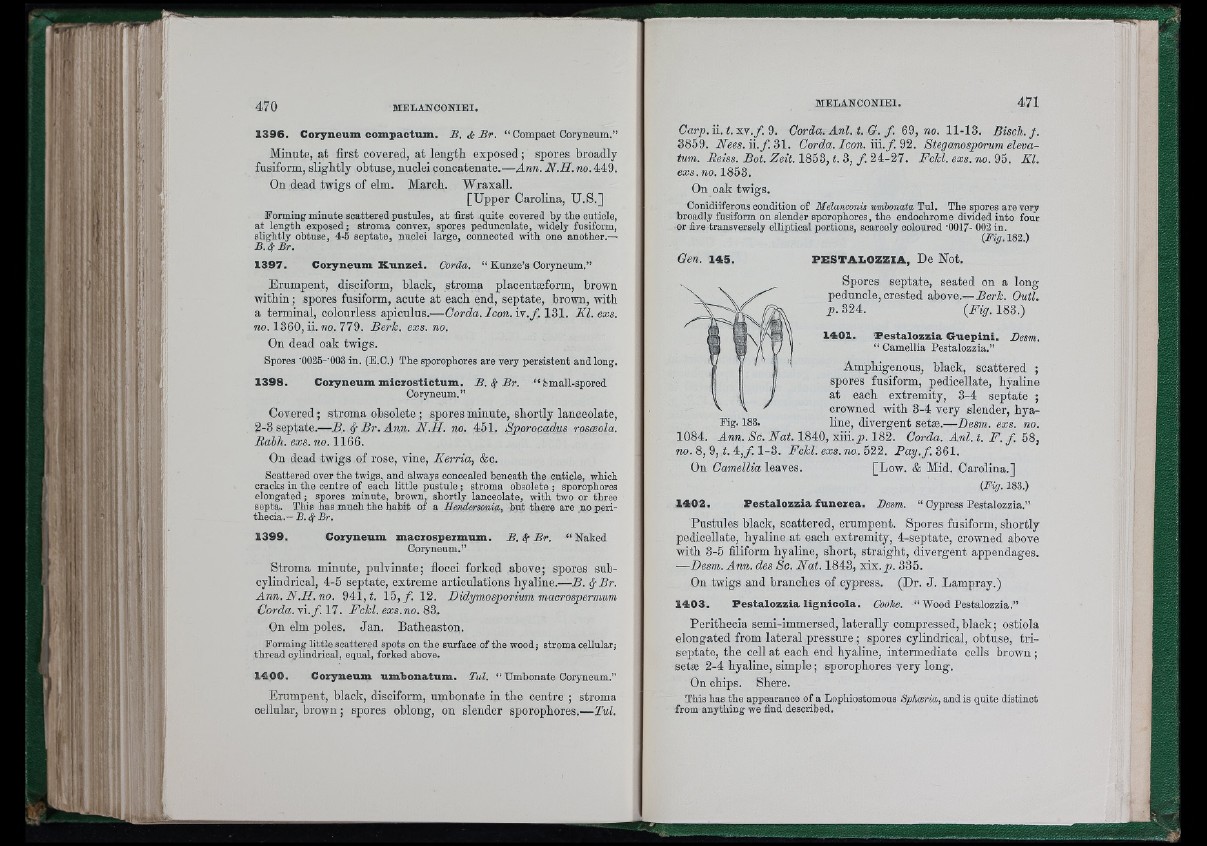
1 3 9 6 . Cozyneum compActum. B .A B r . “ Compact Coryneum.”
Minute, at first covered, at length exposed ; spores broadly
fusiform, sligbtly obtuse, nuclei concatenate.—Ann. N .H . no. 449.
On dead twigs of elm. March. Wraxall.
[Upper Carolina, U.S.]
Forming minute scattered pustules, at first quite covered by the cuticle,
at length exposed ; stroma convex, spores pedunculate, widely fusiform,
slightly obtuse, 4-5 septate, nuclei large, connected with one another.—■
B. 4 Br.
1 3 9 7 . Cozyneum K u n z e i. Corda. “ Knnze’s Coryneum.”
Erumpent, disciform, black, stroma placentæform, brown
witbin ; spores fusiform, acute at eacb end, septate, brown, with
a terminal, colourless apiculus.— Corda. Icon. iv ./. 131. Kl. exs.
MO. 1360, ii. MO. 779. Berh. exs. no.
On dead oak twigs.
Spores •0025-'003 in. (B.C.) The sporophores are very persistent and long.
1 3 9 8 . Cozyneum m ic z o s tic tum . B . 4 B r. “ fcmall-spored
Coryneum.”
Covered ; stroma obsolete ; spores minute, shortly lanceolate,
2-3 septate.—B. 4 Dr. Ann. N .H . no. 451. Sporocadus rosoeola.
Bahh. exs. no. 1166.
On dead twigs of rose, vine, Kerria, &c.
Scattered over the twigs, and always concealed beneath the cuticle, which
cracks in the centre of each little pustule ; stroma obsolete ; sporophores
elongated ; spores minute, brown, shortly lanceolate, with two or three
septa. This has much the habit of a Hendersonia, but there are no perithecia.—
B. 4" Br.
1 3 9 9 . Cozyneum ma c zo sp ezmum.
Coryneum.”
B . 4- B r. “ Naked
Stroma minute, pulvinate; flocci forked above; spores sub-
cylindrical, 4-5 septate, extreme articulations byaline.—B. 4B r.
A n n . N .H . no. 941, t. 15, / 12. Didymosporium macrospermum
C o rd a .y i.f 17. Fchl. exs.no. 83.
On elm poles. Jan. Batheaston.
Forming little scattered spots on the surface of the wood; stroma cellular;
thread cylindrical, eqnal, forked above.
1 4 0 0 . Cozyneum um b o n a tum . Tal. " Umbonate Coryneum.”
Erumpent, black, disciform, umbonate in the centre ; stroma
cellular, brown ; spores oblong, on slender sporophores.—Tul.
Carp. ii. t. X V ./ 9. Corda. Anl. t. G. f . 69, no. 11-13. Bisch. /
3859. Nees. ii./. 31. Corda. Icon. iii./. 92. Steganosporum elevatum.
Beiss. Bot. Zeit. 1853, t.3, f . 24-27. Fchl. exs. no. 95. Kl.
exs.no. 1853.
On oak twigs.
Conidiiferons condition of Mdanconis wmbonaia Tul. The spores are very
broadly fusiform on slender sporophores, the endochrome divided into four
or five transversely elliptical portions, scarcely coloured "0017- 002 in.
(« y . 182.)
Gen. 1 4 5 . FESTALOZZIA, De Not,
Spores septate, seated on a long
peduncle, crested abore.— Berh. Outl.
p . 324. (Fig. 183.)
1 4 0 1 . F e s ta lo z z ia G u e p in i. Desm.
“ Camellia Festalozzia.”
Amphigenous, black, scattered ;
spores fusiform, pedicellate, hyaline
at eacb extremity, 3-4 septate ;
crowned with 3-4 very slender, bya-
Fig. 183. line, divergent setæ.— Desm. exs. no.
1084. Ann. Sc. Nat. 1840, xiii.)». 182. Corda. Anl. t. F . f . 58,
M O . 8 , 9, i. 4 ,/. 1-3. Fchl. exs. no. 522. P a y .f. 361.
On Camellia leaves. [Low. & Mid. Carolina.]
{Fig. 183.)
1 4 0 2 . F e s ta lo z z ia fu n e z e a . Besm. “ Cypress Festalozzia.”
Pustules black, scattered, erumpent. Spores fusiform, shortly
pedicellate, hyaline at eacb extremity, 4-septate, crowned above
witb 3-5 filiform hyaline, sbort, straight, divergent appendages.
—Desm. Ann. des Sc. Nat. 1843, xix. p. 335.
On twigs and brancbes of cypress. (Dr. J . Lampray.)
1 4 0 3 . F e s ta lo z z ia lig n ic o la . Cooke. “ Wood Festalozzia.”
Peritbeoia semi-immersed, laterally compressed, black; ostiola
elongated from lateral pressure ; spores cylindrical, obtuse, tr iseptate,
tbe cell at eacb end byaline, intermediate cells brown ;
setæ 2-4 byaline, simple; sporophores very long.
On cbips. Sbere.
This has the appearance of a Lophiostomoua Sphceria, and is quite distinot
from anything we find described.